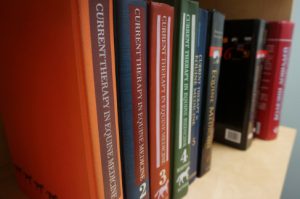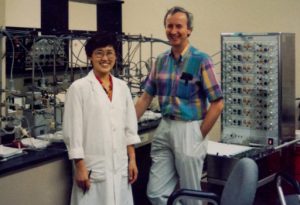*A brillianteer is one who polishes the facets of a diamond, determining how much brilliance and fire it displays
Aim high, take risks, appreciate the diverse talents in your team, and look for money in lots of places. Robinson sees these as some of the most important components of growing a world-class research program.

“I set out to improve the care of horses, through finding new knowledge, writing about that knowledge, and teaching that knowledge.”
Robinson achieved what he set out to do. His research has changed scientific understanding and clinical treatment of respiratory disease. He has edited 6 editions of the canonical text on equine clinical therapies, and has written nearly 300 papers and book chapters. His publications have been cited more than 3,000 times in human and veterinary medical journals. He has shared his knowledge through his publications and through teaching dozens of graduate and post-doctoral students, and thousands of DVM students.
In 1972 Robinson joined the faculty of the MSU College of Veterinary Medicine with a joint appointment in the Departments of Physiology and Large Animal Clinical Sciences. By 1988, when he was appointed Matilda R. Wilson Chair in Large Animal Clinical Sciences, he had published roughly 80 articles and mentored students that now are some of the most significant contributors to research in their fields.
Writing and the process of discovery

Writing, and the process of writing, has been central to Robinson’s research from his early days as an investigator. When he began his career at MSU, Robinson joined the cardiovascular research group, which conducted research and wrote papers as a group. They met every Friday morning to write.
“The first author would write before we met,” Robinson says. “We’d then go through the article, beginning at the first line, and write the paper sentence by sentence. And we’d do the same thing with the data. That’s how I learned to write science.”
The Friday writing group, particularly physiologist Jerry Scott, had a strong influence on Robinson. They wrote as a mechanism to promote reflection and the production of new knowledge, and to support forming meaningful inferences from data. For Robinson and Scott, writing together became a process of thinking together. The two co-authored a dozen articles before Scott passed away at the age of 52.
“Jerry taught me to enjoy science—the process of discovery and writing and publishing papers,” Robinson says. “He didn’t approach it as competitive—he said you write the paper, send it in, the reviewers criticize it, you re-write and send it back. It made it more of a process and less intimidating.”
The processes of research, writing, review, and reinvestigation are all part of the same dynamic—they are connected with and influence one another. Teaching, too, is part of that dynamic. Robinson says that you can’t write or teach if you don’t have knowledge to share, but that the process of teaching helps produce new paths of inquiry and new knowledge. Writing and teaching, for Robinson, are critical to science.
"As Dr. Robinson’s graduate student, one of my early efforts was to develop a research question and to write a grant proposal for an NIH Physician-Scientist Award,” says Cheryl Killingsworth, DVM, PhD (’90), DACVS, senior clinical veterinarian, Birmingham VA Medical Center Veterinary Officer, Animal Resources Program, University of Alabama. “He showed me firsthand how the scientific method could work, how to plan experiments, how to devise alternatives, and most importantly to think about research that could benefit both human and animal lives.” Writing was integral to this.
Teaching—science and a sense of wonder

“As a scientist, the more I learn about biology, the more I am in total awe of the world, and how it fits together,” Robinson says. “You’ll never be completely sure.”
The idea that answers always exist—and that research can find those answers—is an idea held by many young thinkers drawn to the sciences.
“The first experiment, when students see the variability of data—it’s terrifying to them,” Robinson says. “They come in thinking the answers will be here, and then they have data points all over. Then the magic of statistics comes in, and you find the means and the way things are happening. It’s fun to watch students go through that process.”
Robinson describes with glee this process by which students come to an awareness of how difficult it is to find any truth, and why terms like confidence exist. Science can have a certain confidence—that, he says, is what it is about. He takes a certain pleasure in the unknowable, and is committed to an ethic that doesn’t force an idea.
“Dr. Robinson built in me the understanding that our intellectual and ethical responsibility in science is to discover the real truth and not the truth as we wish to shape it so we can use it to further our professional careers and individual reputations,” says Andrew Jefcoat, DVM, PhD (’03), DACLAM, University of Wisconsin-Madison School of Medicine and Public Health attending veterinarian, and senior program veterinarian at the Research Animal Resources Center. “That has always stayed with me.”
Robinson teaches that there is a certain amount of pain involved in coming to a truth—or at least a confidence—through review, revision, and the perspective that comes from collaboration.

“If you don’t put your ideas out there for criticism, you’re not going to improve,” Robinson says. “Getting that criticism, it can be painful. But it’s necessary. The students who are tough to guide are the ones who are afraid.”
Robinson sees promising scientists as having courage in the face of failure, a strong curiosity, and a certain ambition. These qualities build an eagerness to learn and to generate ideas, along with a desire to test those ideas.
“Ed’s honest and sometimes tough feedback, his integrity, work ethic, intelligence, patience, and friendliness made him a role model for me,” says Vincent Gerber, PhD (’03), DECEIM, DACVIM, FVH, head of the Swiss Institute of Equine Medicine, and Vetsuisse Faculty at the University of Bern and Agroscope, Switzerland. “What I like best of all, however, is his fine sense of humor and his infectious intellectual enthusiasm and thirst for novel approaches and scientific questions.”
Robinson’s current and final graduate student, Eilidh Wilson, BVMS, speaks of an experience much like those who have come in the decades before her. Like Neil Olson, DVM, PhD (’82), who was the first veterinarian to earn a PhD with Robinson, Wilson says her mentor is “interested in everyone’s ideas and opinions; he creates an environment that allows people to feel valued and generate innovative ideas.”
Hallways, parking lots, racetracks—every place is a teaching space with Robinson. Henry O’Neill, MVB, MS (’12), MRVC, says that even with six editions of Current Therapy in Equine Medicine on the bookshelf, the most valuable lessons he has had from Robinson were during informal conversations in his office or in the parking lot.
“He would walk into your office or lab and start talking about a new idea or one of his most recent daily experiences,” says Keesjan Cornelisse, DVM, MS, PhD (’05), DACVIM, MRCVS. “Some of those resulted in new and original science projects. Getting the best out of you was another of his great strengths. He would focus on what you are good at and develop that as the basis for your research and ambitions.”
